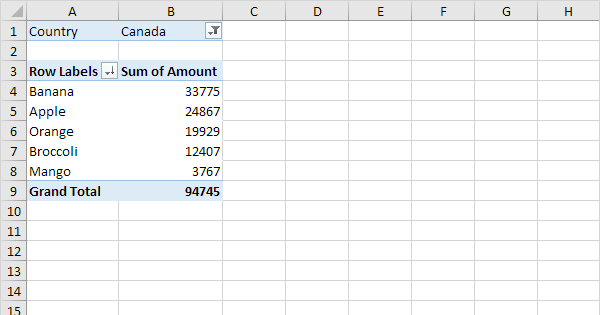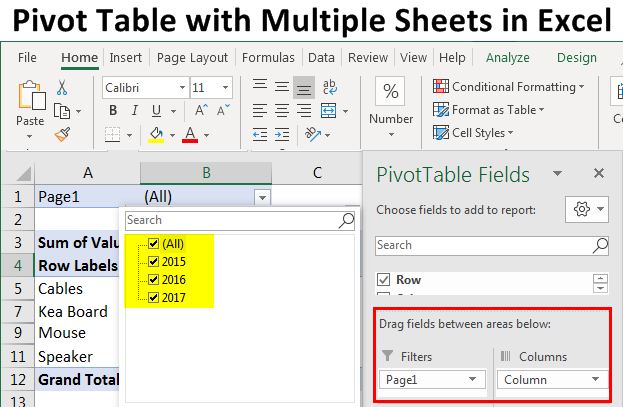

The Formulas, Functions and Visual Basic procedures on this provides examples of Formulas, Functions and Visual Basic proceduresįor illustration only, without warranty either expressed or implied, includingīut not limited to the implied warranties of merchantability and/or fitness forĪ particular purpose. To get products across the top of the report, drag the Product field and drop it in the Columns area: By choosing Region and Revenue, you will create this pivot table:

Checkmark a numeric field and it will appear in the Values area. If you checkmark a text field, it will automatically appear in the Rows area. You can build some reports without dragging the fields. Any fields that you drag to the Rows area appear as headings along the left side of your report. Any fields that you drag to the Columns area will appear as headings across the top of your report. At the top, a list of your fields with checkboxes.Īt the bottom are four drop zones with horrible names and confusing icons. On the right side of the screen is the Pivot Table Fields pane. Click OK to accept the defaults.Įxcel inserts a new blank worksheet to the left of the current worksheet.

Select a single cell in your data and choose Insert, Pivot Table.Įxcel will detect the edges of your data and offer to create the pivot table on a new worksheet. It should have no blank rows, blank columns, blank headings or merged cells. Start with a data set that has headings in row 1. The seller wants to know the total sum of all the items they are selling and the total sum they gained from items which were sold.Pivot tables let you summarize tabular data to a one-page summary in a few clicks. Let’s assume that the seller who organised the garage sale wants to keep track of the items that were sold. In the Excel sheet titled ‘Item List’ we have the following columns: This tutorial uses a template which can be downloaded from here. The template is used to calculate a garage sale inventory and sale. Let’s take a few minutes to understand the problem. We will create a pivot table from a spreadsheet to solve a hypothetical problem. A sample project to create a pivot table. Pivot tables help you easily create reports from your data.You can easily identify patterns in the data with the help of pivot tables.
Tips on how to use pivot tables in excel manual#
Pivot tables summarize data present in thousands of rows and save manual effort.You can easily customize pivot tables and choose only the relevant columns, which keeps your analysis focused.You can easily create them with only a few clicks.The advantages of pivot tables are as follows: You can even express them as percentages of total revenue and total cost. This feature will summarize details like revenue and cost by product. With the help of pivot tables, you can do this much more easily. Subsequently, would you need to analyze which product delivers the most profit. Without a tool like a pivot table, you would need to summarize the revenue and cost for each product from thousands of transactions. You want to find out which product sells the most and which product delivers the highest profit percentage. It captures various information like revenue and cost for each transaction. This spreadsheet represents sales data for different products and it lists thousands of sales transactions. Why can learning to create pivot tables help you? Let’s assume that you have a spreadsheet with several thousand rows. You don’t need to change the data in any manner, and neither do you need to add another column for this. A pivot table can help you to gain a perspective based on one of these attributes, whereas another pivot table can provide a perspective on another attribute.įor this, you just need to “rotate” the table, “pivoting” it on the other attribute. You might have thousands of rows in an Excel spreadsheet with multiple attributes or columns. Let’s gain a deeper understanding of this. Why is it called a “Pivot table”? This is because you can rotate or transpose this table using another attribute of your data. You will likely need to create reports based on your data, and a pivot table makes this easy.

It provides useful charts that help you to understand the trends behind your data. A pivot table represents a summary of your data in an Excel spreadsheet. Let’s first understand what a pivot table is - a built-in feature of Microsoft Excel. How can you create a pivot table in Excel? Read on to find out. One such tool that can help you to analyse data is “Pivot table”. You can do a lot with Excel moreover, repositories like Excel template provide very useful templates to improve your productivity. Microsoft Excel is a widely popular spreadsheet software, and there’s a good chance that you use it. If you deal with data, then you probably use spreadsheets.


 0 kommentar(er)
0 kommentar(er)
